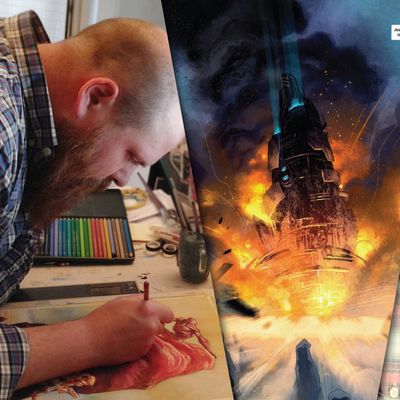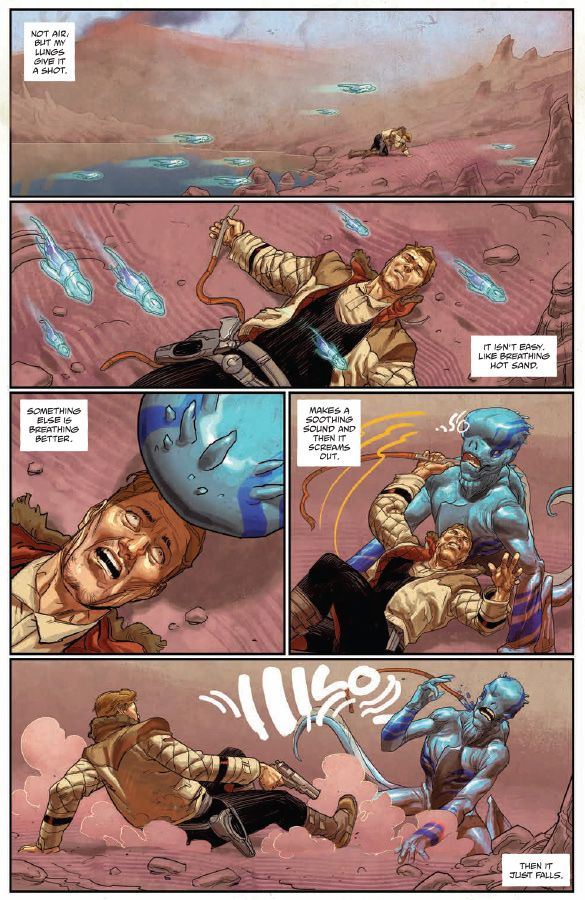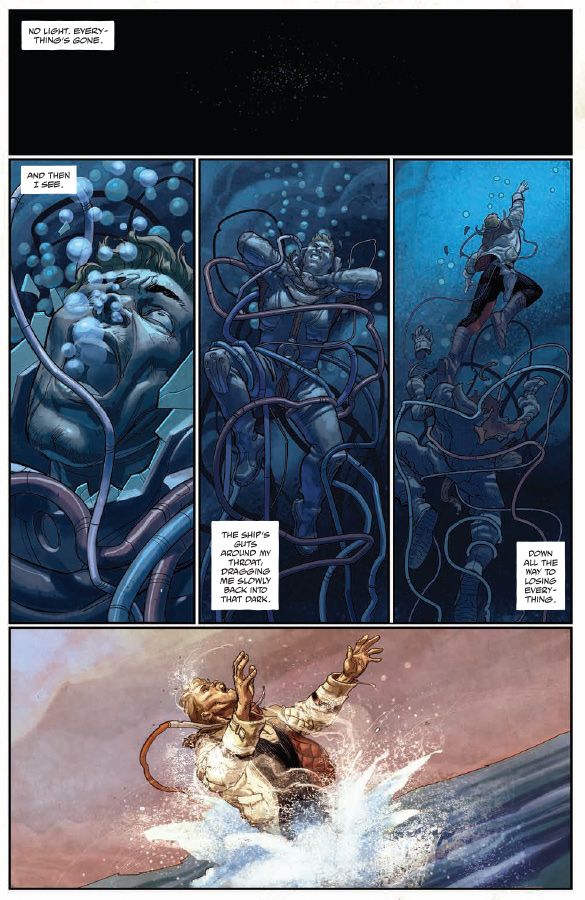
Image ComicsÔÇÖ ongoing series Drifter is as beautiful as it is baffling. This critically acclaimed title debuted last year, and its first few issues get released in a collected edition this week ÔÇö┬áand any reader picking it up should be prepared to clear his or her mind of questions and get immersed in its strangeness. On a very basic level, itÔÇÖs a kind of space Western, in which a mysterious man named Abram Pollux finds himself stranded on a dusty, desert planet inhabited by hard-bitten human settlers and inscrutable native species. Think Deadwood meets Dune.
The seriesÔÇÖ creators are American writer Ivan Brandon and German artist Nic Klein, who previously collaborated on ImageÔÇÖs Viking and were wise to reunite, as they form a potent combination. Brandon lends the dialogue an evocative poeticism, but the main event is KleinÔÇÖs incredible visuals. HeÔÇÖs the rare comics artist who does his pages all by himself, from initial pencils to finished colors. The results are astounding alien vistas, hypnotically odd costuming, and viscerally affecting facial design. I caught up with Brandon and Klein ÔÇö calling in from separate continents┬áÔÇö to talk about Firefly, European comics, and how virtually any information about the comicÔÇÖs origin constitutes a spoiler.
WhatÔÇÖs the genesis for Drifter? Who comes to whom with the idea?
Nic Klein: Actually, we kind of joined two existing ideas weÔÇÖd had of our own for years and fit them together as a kind of meta-idea.
What were the two ideas?
NK: Well, we canÔÇÖt tell you because that would be a major spoiler.
Even on a high level, you canÔÇÖt tell me the overall concepts you merged? How could that be a spoiler?
Ivan Brandon: Well, Nics idea would literally spoil everything. I asked him what kind of thing he wanted to do, and he said sci-fi. I had the very, very beginnings of an idea  I wanted to do a space story thats dirtier, the early stages of colonization; something that wasnt shiny, that wasnt The Jetsons. Then Nic had very specific ideas in terms of  um, again I dont know how to even skirt around it.

So people who read the first volume, when theyÔÇÖre done, theyÔÇÖre not even going to know what the series is remotely about?
IB: They will, but there are underlying mysteries. There are deep questions in terms of what the planet is, when it is, who everyone is. So when you get through the first volume, some questions are answered and some are not. Even the sets are hard to talk about without spoiling. Everything is part of the mystery. The way I see things, story-wise, is: In life, we donÔÇÖt always get the answers when day-to-day things are happening.
A stupid example I always give is this: When I was a student, I used to smoke in front of the high school. One day, this girl came up and just slapped the cigarette out of my mouth and walked away. I never found out why she did that. Life is full of that sort of stuff. You donÔÇÖt get to know why people bob in and out of your life, so we want to handle the storytelling in that organic way. The mysteries are almost a B-plot in that these characters are still going through what theyÔÇÖre going through day to day. I always want that stuff to be engaging enough to entertain people while theyÔÇÖre wondering things.
Are you guys fans of other space Westerns?
IB: I donÔÇÖt really know of any, to be honest. I know people mention Firefly, which I have not seen.
Really, you havenÔÇÖt seen Firefly? IÔÇÖm sure people talk about it all the time when they read this stuff.
IB: IÔÇÖve done about three interviews in the last few days, and it gets mentioned often. ItÔÇÖs weird because a lot of DrifterÔÇÖs┬áWestern elements are intended to grab the thing and dirty it up. ItÔÇÖs less about the Western genre and more about what we felt was a natural context for these characters to live in, and itÔÇÖs the early stage of this colonization where some of the vibes would be similar.
That dovetails into a larger question: Are we not supposed to know when the story is happening?
IB: I donÔÇÖt like the sort of sci-fi where itÔÇÖs all about the period, itÔÇÖs all about the bells and the whistles and the guns and all that stuff. I like it where you can sort of understand the guy is having trouble with his girlfriend, and so on and so forth. Just very simple, human, recognizable obstacles. Obviously, we go a little farther out there in this case, but I never want it to be unrecognizable.
NK: ItÔÇÖs not really important what time in the future it is.

Have you guys ever actually met?
IB: Yes, twice. With Viking issue one, Nic came out and stayed at my house for a couple of weeks in New York. Once, I came out to Germany, and I didnÔÇÖt go all the way out to where he lives, but I did go out to Berlin and he came and met me, and we had a good time.
ÔÇ£All the way out where he livesÔÇØ? Nic, are you in the hinterlands?
NK: ItÔÇÖs Kassel. ItÔÇÖs not a huge city. ItÔÇÖs not really interesting; itÔÇÖs not even interesting to Germans, actually. ItÔÇÖs mainly known for its train station.
Nic, where did you look for visual inspiration for this? It reminds me of Moebius, and Heavy Metal. ItÔÇÖs that style where everyone appears to be wearing something heavy ÔÇö like in the concept art for Alejandro JodorowskyÔÇÖs unproduced Dune movie, where people are out in these desert landscapes and have weird breathing apparatuses. Or Ralph McQuarrie, who did concept art for Star Wars.
NK: I grew up on Moebius, but directly looking for stuff I drew inspiration from  I couldnt even tell you what that would be. I have the tendency to change my style a little bit for every book I do, and the thing that I wanted to do on this book was to have the colors be the star and have the line art pretty much be reduced into line art instead of spotted blacks or shading or crosshatching. The heavy lifting of the visuals would be handled by color.
The colors are really astounding, and youÔÇÖre the rare comics penciler who does them himself. How long does it take you to do a page?
NK:┬áProbably about two days from layout to finished page. Sometimes itÔÇÖs three days a page, depending on how complex it is.
ThereÔÇÖs all this interesting use of light in settings like caves and the open desert. If youÔÇÖre figuring out light sources, do you set up models on your desk or something?
NK:┬áI just work it out in my head. ThatÔÇÖs half the fun, trying to figure that stuff out. IÔÇÖve always done everything like pencils, inks, colors; I think itÔÇÖs more of a European thing. The classic way of working in the U.S. ÔÇö the pencil, the ink, and then the colorist, this kind of production pyramid ÔÇö didnÔÇÖt exist in Europe. It never occurred to me just to learn one element. Plus, IÔÇÖm a control freak. The thought of handing it over to somebody else is enough for me to get sweaty nightmares.
IB: Plus, heÔÇÖs an actual painter, which is pretty rare in American comics ÔÇö someone who can sit down with the canvas and paintbrushes and create a painting.

What were the conversations like when you guys were coming up with the Wheelers, those insane, gorgeous monsters?
IB: ThatÔÇÖs also a tricky one because thereÔÇÖs a spoiler in the Wheelers.
You guys are killing me here!
IB:┬áItÔÇÖs just the toughest book that IÔÇÖve ever had in terms of answering questions because thereÔÇÖs so many spoilers.
NK:┬áIf we explained to you why they look the way they do ÔǪ
IB: Thats the trick. Im just trying to figure out how to  Okay, one thing I can tell you about the Wheelers is theyre supposed to look unfinished.
How about the giant worm creature?
IB: That one was all Nic, actually.
NK: I tried to figure out what a worm that eats rocks would look like.
A worm that eats rocks?
NK: Or digs through rocks, because it would have to have some pretty heavy jaws. Usually I try to think of something from a pseudo-science angle. With the worm, I showed it to my fianc├®e, whoÔÇÖs a biologist, and she was like, ÔÇ£Yeah, maybe make that bigger, and that partÔÇÖs totally nonsensical you should change that.ÔÇØ And I was like, ÔÇ£ItÔÇÖs a comic book!ÔÇØ
Hey, itÔÇÖs your fault for going to a scientist for that.
NK: I just like torture. 

